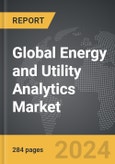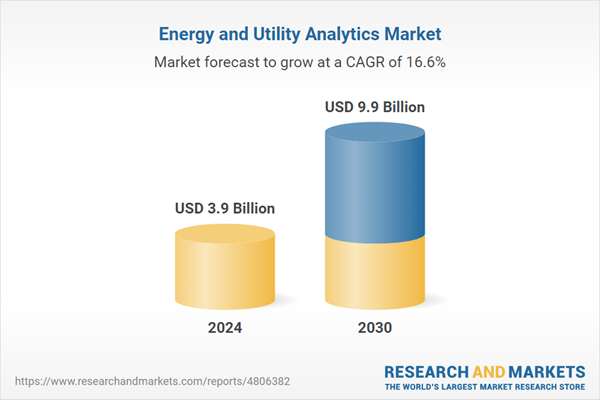Global Energy and Utility Analytics Market - Key Trends & Drivers Summarized
Why Are Analytics Becoming Indispensable in the Energy and Utility Sectors?
Analytics are becoming a cornerstone of operations in the energy and utility sectors, offering critical insights that drive efficiency, cost savings, and improved decision-making. With the vast amounts of data generated by smart grids, smart meters, and other advanced utility systems, analytics tools are essential for turning this data into actionable intelligence. These tools allow utilities to optimize energy production, distribution, and consumption, leading to better resource management and reduced operational costs. Moreover, analytics play a key role in demand forecasting, asset management, and customer service, enabling utilities to respond more effectively to changing conditions and customer needs. As the energy sector faces increasing pressure to integrate renewable sources, reduce carbon emissions, and improve grid reliability, the role of analytics in achieving these goals is becoming ever more critical.How Is Technology Driving the Evolution of Energy and Utility Analytics?
Technological advancements are at the heart of the evolution of energy and utility analytics. The rise of big data technologies, cloud computing, and the Internet of Things (IoT) has expanded the capabilities of analytics platforms, allowing for the collection, storage, and processing of vast amounts of data in real-time. Advanced analytics techniques, such as machine learning, artificial intelligence, and predictive modeling, are enabling utilities to forecast energy demand, identify potential system failures, and optimize grid operations with greater accuracy than ever before. Furthermore, the development of edge computing is enhancing the ability of utilities to process and analyze data closer to the source, reducing latency and improving response times. These technological innovations are not only improving the efficiency and reliability of utility operations but are also enabling more personalized and responsive customer services.Why Are Utilities and Energy Providers Investing Heavily in Analytics?
The growing complexity of utility operations, coupled with the need to transition to more sustainable and resilient energy systems, is driving significant investment in analytics. Utilities are increasingly leveraging analytics to gain deeper insights into their operations, optimize asset performance, and improve grid reliability. The shift towards renewable energy sources, such as wind and solar, requires advanced analytics to manage the variability and uncertainty associated with these resources, ensuring a stable and reliable energy supply. Additionally, the rise of distributed energy resources (DERs), such as rooftop solar panels and battery storage, is adding further complexity to grid management, making analytics essential for integrating these resources effectively. Utilities are also using analytics to enhance customer engagement, offering personalized energy management solutions that help consumers reduce their energy usage and costs. As regulatory pressures to reduce carbon emissions and improve energy efficiency continue to grow, the role of analytics in helping utilities meet these challenges is becoming increasingly important.What Factors Are Driving the Growth in the Energy and Utility Analytics Market?
The growth in the Energy and Utility Analytics market is driven by several factors, including the increasing adoption of smart grid technologies, the growing complexity of energy systems, and the rising demand for renewable energy integration. The proliferation of smart meters and IoT devices is generating massive amounts of data, driving the need for advanced analytics tools that can process and analyze this data in real-time. Additionally, the shift towards renewable energy sources is creating new challenges in grid management, leading to increased investment in analytics to ensure grid stability and reliability. The growing emphasis on energy efficiency and sustainability is also driving demand for analytics solutions that can optimize energy usage and reduce carbon emissions. Furthermore, the increasing regulatory pressure on utilities to meet environmental targets and improve service reliability is pushing them to adopt advanced analytics tools that can provide the insights needed to achieve these goals. As utilities continue to modernize their infrastructure and operations, the demand for sophisticated analytics solutions is expected to grow, further fueling the expansion of the market.Report Scope
The report analyzes the Energy and Utility Analytics market, presented in terms of market value (US$ Thousand). The analysis covers the key segments and geographic regions outlined below.- Segments: Deployment (On-Premise, Cloud); Type (Software, Services); Vertical (Energy, Utilities).
- Geographic Regions/Countries:World; United States; Canada; Japan; China; Europe (France; Germany; Italy; United Kingdom; and Rest of Europe); Asia-Pacific; Rest of World.
Key Insights:
- Market Growth: Understand the significant growth trajectory of the On-Premise Deployment segment, which is expected to reach US$4.3 Billion by 2030 with a CAGR of a 12.2%. The Cloud Deployment segment is also set to grow at 20.9% CAGR over the analysis period.
- Regional Analysis: Gain insights into the U.S. market, valued at $1.1 Billion in 2024, and China, forecasted to grow at an impressive 15.6% CAGR to reach $1.5 Billion by 2030. Discover growth trends in other key regions, including Japan, Canada, Germany, and the Asia-Pacific.
Why You Should Buy This Report:
- Detailed Market Analysis: Access a thorough analysis of the Global Energy and Utility Analytics Market, covering all major geographic regions and market segments.
- Competitive Insights: Get an overview of the competitive landscape, including the market presence of major players across different geographies.
- Future Trends and Drivers: Understand the key trends and drivers shaping the future of the Global Energy and Utility Analytics Market.
- Actionable Insights: Benefit from actionable insights that can help you identify new revenue opportunities and make strategic business decisions.
Key Questions Answered:
- How is the Global Energy and Utility Analytics Market expected to evolve by 2030?
- What are the main drivers and restraints affecting the market?
- Which market segments will grow the most over the forecast period?
- How will market shares for different regions and segments change by 2030?
- Who are the leading players in the market, and what are their prospects?
Report Features:
- Comprehensive Market Data: Independent analysis of annual sales and market forecasts in US$ Million from 2024 to 2030.
- In-Depth Regional Analysis: Detailed insights into key markets, including the U.S., China, Japan, Canada, Europe, Asia-Pacific, Latin America, Middle East, and Africa.
- Company Profiles: Coverage of players such as ABB Group, BuildingIQ, Inc., CA Technologies, Inc., Capgemini SE, IBM Corporation and more.
- Complimentary Updates: Receive free report updates for one year to keep you informed of the latest market developments.
Some of the 22 companies featured in this Energy and Utility Analytics market report include:
- ABB Group
- BuildingIQ, Inc.
- CA Technologies, Inc.
- Capgemini SE
- IBM Corporation
- Oracle Corporation
- SAP SE
- SAS Institute, Inc.
- Schneider Electric SA
- Siemens AG
- Teradata Corporation
This edition integrates the latest global trade and economic shifts into comprehensive market analysis. Key updates include:
- Tariff and Trade Impact: Insights into global tariff negotiations across 180+ countries, with analysis of supply chain turbulence, sourcing disruptions, and geographic realignment. Special focus on 2025 as a pivotal year for trade tensions, including updated perspectives on the Trump-era tariffs.
- Adjusted Forecasts and Analytics: Revised global and regional market forecasts through 2030, incorporating tariff effects, economic uncertainty, and structural changes in globalization. Includes historical analysis from 2015 to 2023.
- Strategic Market Dynamics: Evaluation of revised market prospects, regional outlooks, and key economic indicators such as population and urbanization trends.
- Innovation & Technology Trends: Latest developments in product and process innovation, emerging technologies, and key industry drivers shaping the competitive landscape.
- Competitive Intelligence: Updated global market share estimates for 2025, competitive positioning of major players (Strong/Active/Niche/Trivial), and refined focus on leading global brands and core players.
- Expert Insight & Commentary: Strategic analysis from economists, trade experts, and domain specialists to contextualize market shifts and identify emerging opportunities.
Table of Contents
Companies Mentioned (Partial List)
A selection of companies mentioned in this report includes, but is not limited to:
- ABB Group
- BuildingIQ, Inc.
- CA Technologies, Inc.
- Capgemini SE
- IBM Corporation
- Oracle Corporation
- SAP SE
- SAS Institute, Inc.
- Schneider Electric SA
- Siemens AG
- Teradata Corporation
Table Information
| Report Attribute | Details |
|---|---|
| No. of Pages | 284 |
| Published | December 2025 |
| Forecast Period | 2024 - 2030 |
| Estimated Market Value ( USD | $ 3.9 Billion |
| Forecasted Market Value ( USD | $ 9.9 Billion |
| Compound Annual Growth Rate | 16.6% |
| Regions Covered | Global |









